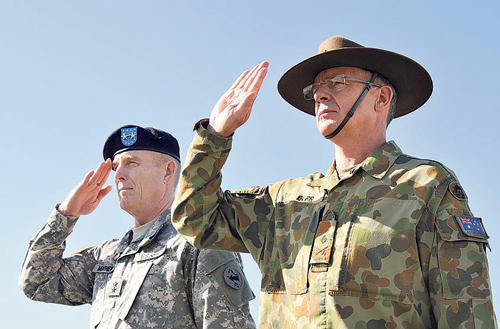Australian general fills vital Fort Shafter position

U.S. Army Maj. Gen. Roger Mathews, left, and Australian Defence Forces Maj. Gen. Richard Burr saluted during a ceremony last month welcoming Burr to Fort Shafter. Burr’s unprecedented appointment to be deputy commanding general at U.S. Army Pacific is the first time a non-American has served in such a high-ranking position at a command like this.
Maj. Gen. Richard Burr salutes with his palm facing out, like he’s shielding his eyes from the sun. He wears a wide-brimmed felt "slouch hat" with a brown and green camouflage uniform.
The two-star general in the Australian Defence Force stands out amid the American soldiers donning berets and green and beige fatigues at the U.S. Army’s headquarters for the Pacific at Fort Shafter. But he’s responsible for directing their training and exercises as U.S. Army Pacific’s deputy commander for operations.
The Army is also making Burr its liaison to New Zealand, his homeland Australia and countries in Southeast Asia.
Burr’s appointment — it’s the first time a non-American has served in such a high-ranking position at a command like this — symbolizes the Army’s push to connect more with allies and friendly nations in the Pacific as it implements the Obama administration’s policy to "re-balance" national defense strategy toward the region.
Burr reports to Lt. Gen. Francis Wiercinski, a three-star general and U.S. Army Pacific’s top commander since 2011. Wiercinski is responsible for most U.S. soldiers in the region, except those in South Korea.
Burr said his presence in Hawaii tells others the U.S. Army is open to broadening its relationships.
Don't miss out on what's happening!
Stay in touch with breaking news, as it happens, conveniently in your email inbox. It's FREE!
"I think it sends a very positive message to all countries in the region — not just our two countries — that stronger partnerships is really the way to go," Burr said in an interview Wednesday, a month after arriving in Hawaii for the new job. "And building from bilateral to multilateral partnerships is the key to a stronger, more stable region."
The position reflects a deepening of an already close relationship between the United States and Australia, two nations that fought together in World War II and whose alliance was formalized by treaty in 1951.
More recently, Australia sent troops to fight alongside the U.S. in Afghanistan and Iraq, even when those decisions were unpopular with voters at home.
Burr was among the deployed. He commanded Australian troops in Afghanistan in 2002 and during the invasion of Iraq the following year. In 2008 he commanded all coalition special forces — including Americans — in Afghanistan.

The 49-year-old said these experiences mean Americans know him, and know he takes the responsibility of commanding U.S. troops seriously. This helps the U.S. feel comfortable placing him in such a critical position.
"This is quite unique," he said. "You’re sort of letting someone in to look in your undies drawer. You want to have trust."
So far, Burr has been to Japan, where he partnered with a Japanese general to run an annual U.S.-Japanese exercise called Yama Sakura. Soon he’ll go to Thailand to do a similar job for the Cobra Gold exercise involving seven nations: Thailand, the U.S., Singapore, Japan, Indonesia, South Korea and Malaysia. Australia will send an observer.
Burr said it’s good to have people from different militaries work together daily so they’re already used to each other when they have to respond to a natural disaster or go into combat. Nations tend to act as a multinational coalition, whether to deliver humanitarian assistance or send troops to fight, he said.
"My personal view is the more you can organize and practice that in a day-to-day sense, the better you will be at responding to those challenges, which usually happen at short notice," he said.
Ralph Cossa, president of the Pacific Forum CSIS think tank, said putting a foreign officer in the direct line of command shows "unprecedented closeness."
Denny Roy, a senior fellow at the East-West Center in Honolulu, said Australia has long partnered with major powers holding similar values — first Britain and now the U.S. — to influence the much more populous, sometimes dangerous, economically larger world to its north.
Burr’s appointment shows Australia is firmly in the inner circle of U.S. allies. Being there helps Australia influence its partnership with the U.S. and have its voice heard. It also gives Australia access to the latest intelligence and helps it understand how the U.S. thinks and acts.
"Australia is in," Roy said. "Australia ought to take this as a very positive vote of confidence and signal of strong partnership between the U.S. and Australia," he said.
Burr said he looks forward to taking in Hawaii’s water sports during the couple of years he expects to be in Hawaii, such as diving, kayaking and surfing. He’s already tried stand-up paddling.
"Despite coming from Australia, I’m not a surfer," he said. "But I will be by the time I leave."



